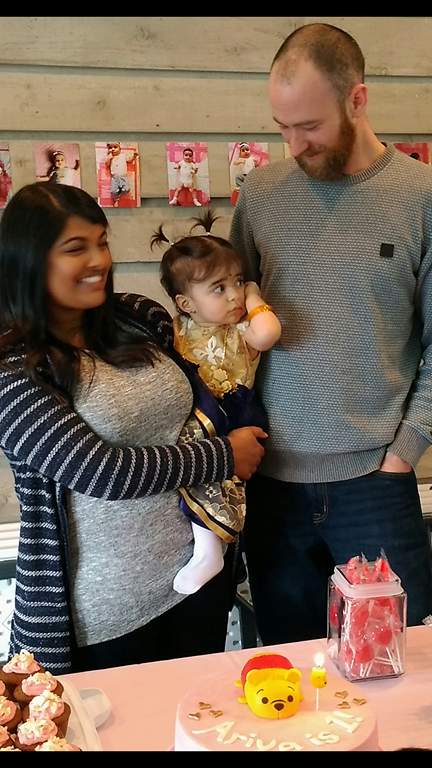A Future for Ariya
The photo above showcases my baby cousin, Ariya, at her 1st birthday celebration in February of 2017 at her grandparents’ house in Richmond. She is being held by her mother, Neela, as her father Michael (who is my cousin) looks lovingly upon her. This picture also demonstrates Ariya’s multiracial heritage, being half Indian and half European. Here, we see Ariya sport a bindi much to the stressed importance of her mother, who is extremely proud of her heritage and wants to pass it along to her daughter, and rightfully so. I feel a special sort of connection with Ariya, as we share a multiracial identity. I am half Chinese and half European. However, I am growing increasingly worried for the type of world that she is going to grow up in, especially with her having a Brown identity. As discussed by Katie Macdonald and seen through “The Girl Effect” video viewed in class, certain initiatives centered around girls in the “Third World” have actively perpetuated tropes and stereotypes onto Brown girls in a global sense who are living in a “Third World” country. Though these stereotypes are directed at these Brown populations across the globe, I find that they also latch themselves locally onto the Brown populations, specifically girls, living here in North America and affect how they are viewed in daily life. I desire a better future for my cousin than to be viewed like this due to the colour of her skin, heritage, and gender, and I look to a transnational form of feminism to break apart these ideas and stereotypes.
In her analysis, Katie Macdonald breaks down many of the tropes that these education initiatives directed at girls in the Third World are spreading globally. Macdonald discusses how these initiatives, specifically Greg Mortenson’s Three Cups of Tea, Plan International’s “Because I am a Girl”, and the United Nations Girls Education Initiative (UNGEI), create a “homogenization” of what a “Third World Women” is (Macdonald, 2016, pg.2). Due to the nature of these organizations advertising to Westerners for their support, a sort of “saviour” complex is born through the “image of a (mostly brown) girl who is need of empowerment” (Macdonald, 2016, pg.13). These images often create this idea that Brown girls and women, whether they be from India or Pakistan or Afghanistan, are “perpetually oppressed” (Macdonald, 2016, pg.1) and are assumed that because of being Brown and living in these countries, they must be saved by the ever-so-gracious Westerner. These Brown girls living in these places are assumed to have zero agency of their own, because of who they are and where they live. This construction of a “Third World Women”, who is always oppressed and in need of saving, is heavily racialized to be a Brown girl. “The Girl Effect” video watched in class also reinforces this idea, as it uses language such as “village” and describes an economy which can be shaped by a single goat, hinting that the population of girls in need of help are Brown or Black in nature. This goes off of basic stereotypes that all Brown and Black populations across the ocean live like this.
These ideas and stereotypes which are projected globally onto Brown girls and their populations can also be seen in a local sense in North America. Since the ideas of oppression and “saving” are attached to Brown girls and that they are all homogenized or the “same”, their cultures become subject of criticism and are mostly blamed by Westerners to be the cause of their oppression. Here, in North America, popular stereotypes that are connected to Brown girls is that their culture is inherently misogynistic in nature, and that “brown girls” need to be saved from “brown men”, specifically by “white men”, (Macdonald, 2016, pg.7) or Westerners. It is believed that “western women’s freedom” or more specifically White women’s freedom, is the standard/end goal, with anyone who is not White being “backwards and behind” (Macdonald, 2016, pg.6). These stereotypes, perpetuated globally by Third World education initiatives, also find their way here in North America to latch on to Brown women and subject them to being viewed differently and also still in need of “saving”.
Because of the points above, I truly am worried for my baby cousin Ariya growing up and being treated like this and automatically stereotyped because she is a Brown girl. However, it does not have to be like this. Using a transnational feminist lens, we can break apart these stereotypes and acknowledge and spread the fact that these ideas are heavily racialized, gendered, and homogenized in nature. In my cousin’s case, it is of special importance that we apply transnational feminism, as her very identity is intersectional and transnational in nature (Valoy, 2015), as she is multiracial. By using transnational feminist view to analyze gender, race, and other facets of identity, we can break apart the idea that because my cousin is Brown, she must be inherently “oppressed and lacking agency” (Valoy, 2015). This is the global, feminist future I wish for Ariya.
Works Cited
MacDonald, K. (2016). Calls for educating girls in the Third World: Futurity, girls and the ‘Third World Woman’. Gender, Place & Culture, 23(1), 1-17.
Valoy, P. (2015, January 23). Transnational Feminism: Why Feminist Activism Needs to Think Globally. Retrieved April 5, 2017, from http://everydayfeminism.com/2015/01/why-we-need-transnational-feminism/
